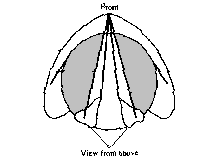Phonation
neat stuff done by the vocal folds
Anatomy
The vocal folds (or cords) are two flaps of tissue attached to
the cartilages of the larynx (or voicebox). Muscles can move the
cartilages in order to adjust the position and tension of the
vocal folds.


Glottal states / Types of phonation
We've been acting as if only one question mattered: are the
vocal fold vibrating or not? Segments with vocal fold vibration
are voiced, all others are voiceless.
There's more than one way the vocal folds can vibrate. There's
more than one way they can fail to vibrate.
Not vibrating

Glottal stop
The vocal folds are held together without vibrating. No air escapes
from the lungs.
Open breathing
The vocal folds pulled as far apart as possible -- no sound.
Voiceless
The vocal folds are too far apart to vibrate, but close enough that
they can cause some turbulence in the airstream under the right
circumstances. (This is what "voiceless" usually means.)
Whisper
Vibrating
Modal voicing
The vocal folds are held together along their full length with
enough tension to allow vibration:
- The vocal folds momentarily block airflow from the lungs.
- The air pressure underneath the vocal folds increases.
- The increased pressure forces the vocal folds up and apart.
- As the pressure falls again, the vocal folds snap back
together.
- Go to 1.

Each repetition of this cycle causes a "glottal pulse". The
number of times this occurs in a second is the fundamental
frequency of voice.
Varying the tension of the vocal folds results in different rates
of vibration (and so different pitches).
Breathy voice (or murmur)
The vocal cords are vibrating, but there is also a significant
amount of air escaping through the glottis, causing turbulence.
Creaky voice
In creak, only the front part of the vocal folds are
vibrating, giving a very low frequency. (Try speaking at the
lowest pitch you can. Then go even lower.)
The very low frequency vibration of creak can be superimposed on
modal voicing, producing creaky voice.
Creak and creaky voice are often called "laryngealization" or "vocal
fry".
Falsetto
The vocal folds are stretched tightly so that they become very
thin. The resulting vibrations can have over twice the frequency
that a speaker can produce using modal voicing.
Combinations
Various combinations of the above are possible. For example, you
can get a creaky falsetto by superimposing creak onto falsetto
voicing rather than modal voicing (think Grover on Sesame
Street).
Non-linguistic uses of voice quality
People may use different types of phonation in different
situations, either consciously or unconsciously (e.g., whisper
when telling a secret, breathy voice when excited, creaky voice
during a hangover).
A person's tendency to use various (combinations of) types of
phonation is one of the most important things that makes their
voice "theirs".
People who need to talk in two or more different identifiable
voices (e.g., puppeteers) will usually use different phonation
types for the different voices.
Speech/language pathologists usually make a distinction between
- articulation disorders
- voice disorders (problems with phonation)
roughly the distinction between filter and source.
The goal of much therapy is to help the client gain an
appropriate use of modal voicing.
("Voice quality" is often also used to describe aspects of the filter,
specifically vocal tract "settings" that persist over a stretch of speech.
For example, if the average position of the tongue
body during an utterance is markedly higher and further forward
than it normally is in the speech community, some people will say
that the utterance has "palatalized voice".)
Transcribing
The "Extended IPA" offers ways of transcribing voice quality.
Stretches of speech with a particular voice quality can be marked
with curly braces. The braces are labelled with a symbol for
the voice quality, for example:

Linguistic uses of voice quality
Moving into a different phonation type (especially creaky voice)
can help signal parenthetical comments:
- The phonetics course {
 which is really interesting
which is really interesting  } is almost
over.
} is almost
over.
Ordinary voiceless phonation (sometimes whisper) can be used to
produce voiceless vowels and [h].
Many languages use the glottal stop phonation by itself, treating
it as a segment. (Phonological "glottal stops" are often
realized with creak or creaky voice instead.)
Phonation types can create contrasts between segments.
Deviations from ordinary voicelessness or modal voicing are
marked with diacritic symbols.
E.g., contrasts between:
- a vowel with modal voicing
- a vowel with breathy or creaky voicing
- a voiceless aspirated stop
- a "voiced aspirated" stop, i.e., a stop with breathy voice
phonation. After the release of the stop, the breathy voice
continues for an interval before the onset of modal voicing
(parallel to the lag in Voice Onset Time in voiceless aspirated
stops).
Different pitches of modal voicing can be used in tone
languages to create contrasts between segments. We've
already seen the uses of different pitch in the suprasegmental
system of English.
Previous: Vowels (continued)
Up: table of contents







 which is really interesting
which is really interesting  } is almost
over.
} is almost
over.